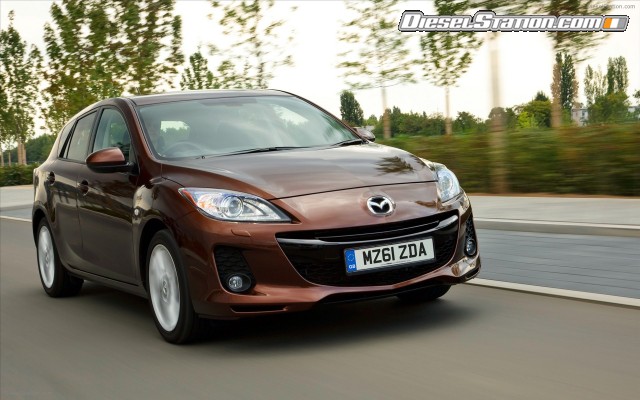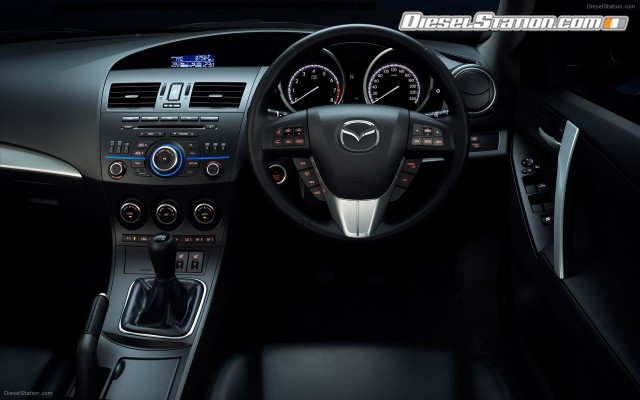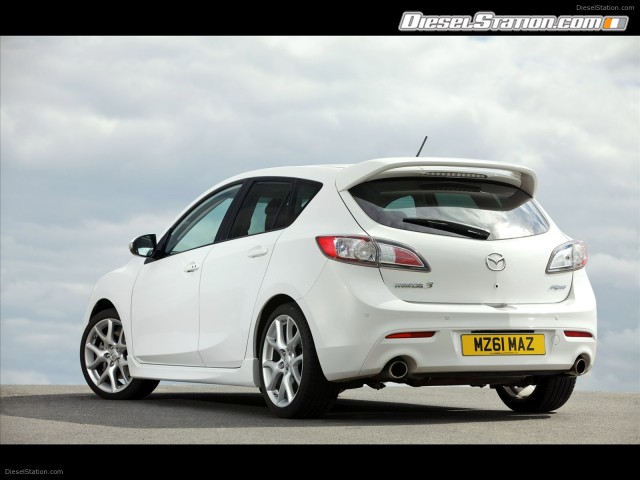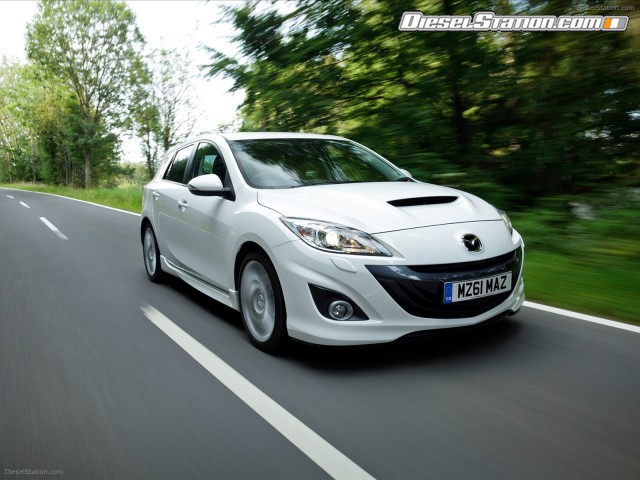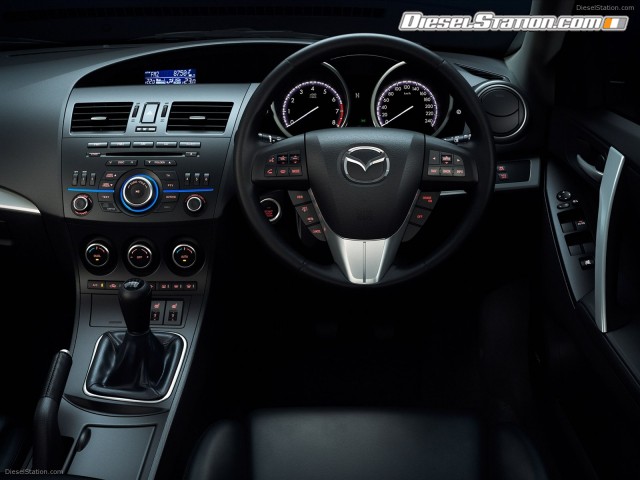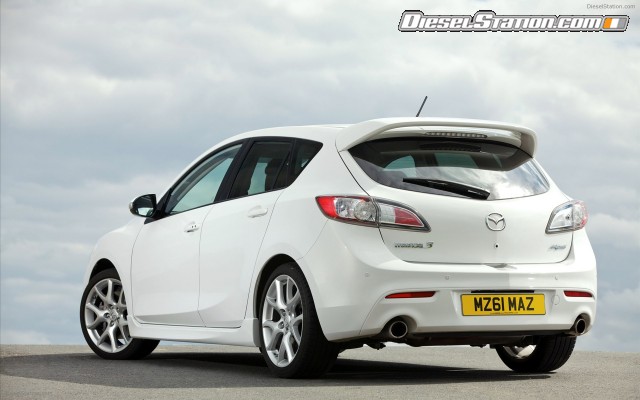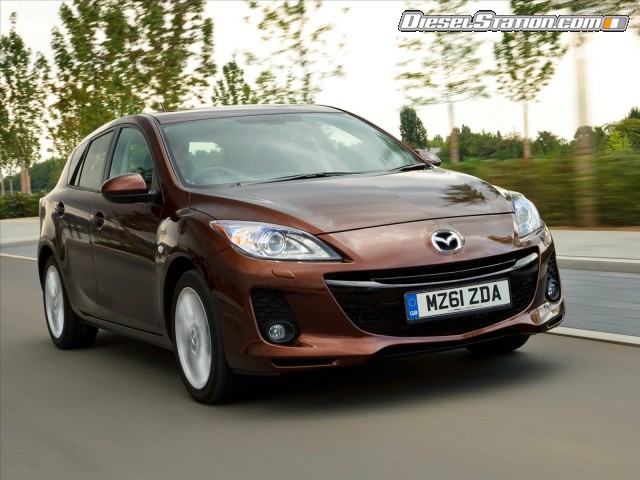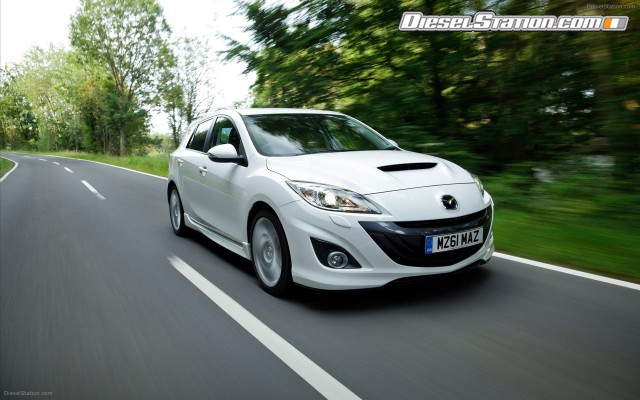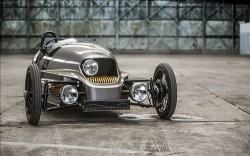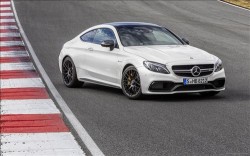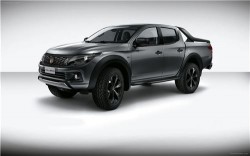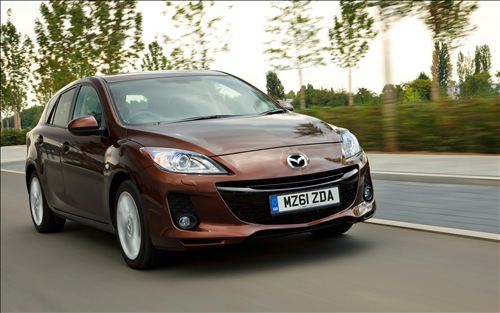Mazda released an upgraded Mazda 3 2011 for the European Market. The upgraded version has almost everything upgraded from bumper to bumper... If so many upgrades, then why not release a new special edition rather than a upgraded version!
DESIGN REFINEMENT
Exterior
- New front bumper design for higher emotional appeal and aerodynamic efficiency
- New rear bumper design unified for all grades (except MPS version)
- Rear reflectors moved outboard for a strong, athletic look
- New 16 and 17-inch ‘curved’ wheel designs complement dynamic silhouette
- Eight exterior colours, including all-new Autumn Bronze Mica
- Sporty five-door hatchback body style with rear roof spoiler as standard
- High-performance flagship model Mazda3 MPS
Interior
- New black colour for lower centre console with chrome rings on control dials for faster recognition while driving
- New sharp white graphics for multi-information display (MID)
- New continuously-lit white numbers on grey instruments for easier daylight readability
DRIVING DYNAMICS
- Applied Toitsukan ensures smooth transitions between acceleration, lateral and deceleration G forces in response to the basic aspects of driving, turning and stopping – delivering a more linear and consistent driving feel
- Stiffer wheels for better straight-line stability
- Underbody structure stiffened by new forward cross-member reinforcement made of stronger steel, with more spot welds and a new single brace bar
- Front tyre air deflector stiffness increased by 50 percent for further enhanced driving stability
- Increased sense of stability in ride feel through optimising damper tuning
- New pump-flow characteristics for electric power steering improves feedback and road feel at mid to high speeds
- Improved drag coefficient (Cd) of only 0.29 for the hatchback (formerly 0.30) achieved by:
- New front bumper design that streamlines and guides air-flow more efficiently
- Increased rigidity of front tyre air deflectors that help prevent deformation
- New 10 percent larger flat floor undercover for improved air-flow
- Improved NVH with B-frame that is thicker with more welding points and increased underbody insulation for reduced road noise and a quieter cabin
- MacPherson strut front, multi-link rear suspension [carry-over]
- Front ventilated, rear solid disc brakes [carry-over]
POWERTRAINS
Diesels
- High-performance yet frugal MZR-CD 2.2-litre turbo diesel in two derivatives with six-speed manual gearbox:
- High Power: 185ps / 136kW at 3,500rpm and 400Nm of torque at 1,800-3,000rpm. Combined fuel consumption of 5.4 l/100km (3.6 percent lower) and CO2 emissions of 144g/km (down 3.4 percent)
- Standard Power: 150ps / 110 kW at 3,500rpm and 360Nm of torque at 1,800-2,600rpm. Combined fuel consumption of 5.2 l/100km (down 3.7 percent) with CO2 emissions of just 139g/km (down 3.5 percent)
- MZ-CD 1.6 turbo diesel engine produces 115ps / 85 kW and a robust 270Nm of torque between 1,750 and 2,500rpm. With the 6-speed manual this model uses just 4.3-litres of fuel per 100 km combined (down 2.3 percent) and produces a low 115g/km of CO2 (down 1.7 percent)
Petrols
- MZR 2.3 DISI Turbo petrol with six-speed manual transmission (Mazda3 MPS only) produces high performance of 260ps / 191 kW at 5,500rpm and 380Nm of torque at 3,000rpm. This model has a top-speed 250km/h and accelerates from 0 to 100km/h in 6.1sec. [carry-over]
- MZR 2.0 DISI i-stop petrol engine with six-speed transmission produces 150ps / 110 kW at 6,200rpm and 191Nm of torque at 4,500rpm. It requires 6.7-litres of fuel per 100km (down from 6.8) and produces 157g/km of CO2 (down from 159)
- MZR 2.0 naturally-aspirated petrol with five-speed automatic transmission produces 150ps / 110 kW at 6,500rpm and 187Nm of torque at 4,000rpm, while using 7.6 litres of fuel per 100km and producing 175g/km of CO2 [carry-over]
- MZR 1.6-litre naturally-aspirated petrol with five-speed manual transmission produces 105ps / 77 kW at 6,000rpm and 145Nm of torque at 4,000rpm, while using 6.4 litres of fuel per 100km and producing 147g/km of CO2 (down from 149)
- MZR 1.6-litre petrol with 4-speed Automatic transmission needs just 7.6-litres of fuel per 100km and produces 176g/km of CO2. Automatic allows driving in fully automatic mode with slope control and optimised kick-down from fourth-to-second gear, or in sequential-manual mode [carry-over]
EQUIPMENT & SAFETY
- New, affordable integrated Mazda navigation system based on TomTom® technology navigation system* introduced offering four4 GB memory and 18 languages, a large 5.8 inch touch screen monitor, and hands-free Bluetooth® telephoning and audio connection with external microphone
- New gear-shift indicator for smooth and fuel-efficient driving (for manual transmission 1.6 and 2.0 DISI petrol engines, and all diesel engines)
- Park brake with new leather handle standard on all models
- New all-leather gear-shift lever (upper grades and MPS)
- Leather seats with three memory functions plus two integrated in the keyless entry and start system transmitter* [carry-over]
- Optional 10-speaker Bose® premium surround sound system, with Audiopilot2® noise compensation and Centrepoint® surround system* [carry-over]
- Hands-free system for Bluetooth®-equipped mobile phones and mobile audio players* [carry-over]
Passive safety (all standard)**:
- Front, side, curtain airbags standard in all markets
- Active front head restraints that protect the neck against whiplash
- Double pre-tensioner front seatbelts with digressive load-limiter retractors (LLR)
- Crushable brake pedal, crushable pads below the heel area, energy-absorbing steering column
- Soft, energy-absorbing ribs at each corner of the cabin
- Bonnet cowl, fender bracket and bumper beams optimised for pedestrian safety
- Mazda Advanced Impact-energy Distribution and Absorption System offers highly rigid and protective body
Active safety**:
- Anti-lock Braking System (ABS), Electronic Brake-force Distribution (EBD), Dynamic Stability Control (DSC), Emergency Brake Assist (EBA) and Traction Control System (TCS) (standard)
- Emergency Stop Signal (ESS) that warns cars behind of a sudden braking manoeuvre by automatically flashing the hazard lights rapidly (standard)
- Rear-vehicle monitoring (RVM) system*
- Parking sensor systems*
- Bi-xenon headlamps with pivoting adaptive front lighting system*
2. Introduction
The enhanced Sports Compact
When the very first Mazda3 was launched in 2003 it was more than a continuation of Mazda’s long history of compact cars, it was a revelation. The new compact looked much sportier than most compacts at the time and was exciting to drive. People took notice and Mazda3 quickly led the way in a rebirth of the Mazda brand around the world, reaching the One-million production milestone in a record time.
The current second-generation model followed in 2008 and introduced an aggressive front end design. It remains the company’s most popular car with over 2.7 million sold globally. Europe is the car’s second-largest market worldwide with total sales of 613,000 units, nearly 100,000 of these from the current model achieved in less than two years. With almost 60,000 units sold in 2010, the Mazda3 is the best-selling vehicle for Mazda in Europe.
Mazda3 has accumulated 125 global accolades since originally launched, including several Car of the Year awards. The first-generation won 99 of these over a five-year period, while the current model has already taken home 26 awards.
“For the Upgraded Mazda3 we targeted a high level of comfort that would enable the driver and passengers to enjoy the ride in various driving conditions. We also wanted the car to be fun to drive with precise handling. Specifically, we focused on refining the driving feel by making the different vehicle movements — driving, turning and stopping — flow together more seamlessly. We call this Toitsukan, which translates as a consistent and linear driving feel. Thanks to its more linear behaviour, as well as improvements to the already impressive high-speed stability, the Upgraded Mazda3 is more pleasing than ever to use on a daily basis.” Kenichiro Saruwatari, Mazda3 Program Manager
The current second-generation Mazda3 has built a strong reputation as one of Europe’s sportiest compacts. In some markets it comes in two body styles, each with its own distinct character: the smooth, sporty elegance of the four-door saloon, and the muscular strength of the five-door hatchback sold in the UK. For even sportier tastes there’s the Mazda3 MPS, which is one of the most powerful front-wheel drive compacts in the world.
Besides this strong emotional appeal, state-of-the-art technology and a long list of equipment make Mazda3 frugal, fun and easy to use. It has a powertrain line-up of five petrols (including two DISI direct injection petrol engines), three common-rail diesels, five and six-speed manual transmissions, and four and five-speed automatic transmissions.
A long list of standard equipment and options – like a premium 10-speaker Bose® stereo system and Bluetooth® MP3 capability – make the ride an enjoyable one. Park assist makes city parking easier, and adaptive front Xenon headlights, tyre-pressure monitoring, rear vehicle monitoring (according to grade/option) and ESS (Emergency Stop Signal) – along with standard front, side and curtain airbags– deliver superior safety.
3. Design Refinement
Even more Aggressive and Easier to Use
When it comes to head-turning good looks, Mazda3 is already one of the market’s most appealing compact line-ups with an aggressive hatchback and a sporty yet elegant saloon in some markets. This visual impact was confirmed when a poll of 200,000 AutoBild readers across Europe voted Mazda3 Europe’s best-looking compact.
For the upgraded version, designers focused on updates that would enhance the car’s emotional appeal. They redesigned the front end to be more aggressive and aerodynamic, and reduced rear bumper thickness. These changes give the exterior a well-toned muscular appearance that underscores the car’s solid build quality. This focus was carried through to the inside as well, where new materials and colours enhance quality feel, while the optimised ergonomics make the Mazda3 easier to use.
EXTERIOR
Front End – Evolution of Mazda3’s Dynamic Styling
The current Mazda3 introduced a new front end that gave the car a unique sporty edge that is immediately recognisable as embodying ‘Zoom-Zoom’. This continues with the Upgraded Mazda3. The friendly yet sporty front face with large five-point grille is updated to create a richer and more stylish impression. The corners of the front bumper now have a larger fascia around the air inlets, new round fog lights embedded in their lower sections, and a lower front lip that protrudes more than before. These changes not only give the Upgraded Mazda3 a more aggressive and emotionally appealing look, they improve aerodynamic performance as well.
Hatchback Rear End Design – Less Means More
Changes were also made at the back of the Mazda3 five-door hatchback. The rear bumper is not as thick as before (it protrudes 30 mm less than the outgoing Sports-grade hatchback) and the reflectors are moved outboard, closer to side panels. As a result, the upgraded hatchback looks even wider and more solidly built when seen from the back. The shortened rear bumper allows easier loading and unloading of the luggage compartment, and the overall length of the car is now 4,460mm for all models.
New Wheel Designs and Colours
The sporty silhouette of the Upgraded Mazda3 is complemented by new 16-inch and 17-inch wheel designs with more spokes that are twisted slightly backwards to give a dynamic, lighter look even when the car is standing still. Customers can choose between eight exterior colours: an all-new Autumn Bronze Mica, plus Indigo Blue Mica, Velocity Red Mica, Crystal White Pearl Mica, Arctic White, Aluminium Metallic, Graphite Mica and Black Mica.
INTERIOR
Cockpit – Now Easier to Use
The insightful combination of design and functionality continues on the inside of the Upgraded Mazda3 with updates which create a more stylish interior that is also functional and easier to use. The current Mazda3 already delivers superior cockpit ergonomics with a driver-orientated sporty dashboard, great all-round visibility, telescopic and height adjustable steering wheel, driver’s seat height adjustment, and a high-mounted gear shift lever that allows easy shifting with a flick of the wrist.
Leaving this unchanged, designers focused on lowering the number of eye-movements it takes to use the car’s onboard systems from behind the wheel. To realise this, they replaced the previous silver of the lower section of the dashboard middle console with black colour, and ringed the dials and controls that are most-used by the driver in brighter satin-polish silver that’s easier to see.
They also changed the red graphics of the current model’s multi-information display and Liquid Crystal Display (LCD) (under the instrument panel hood) to a crisp white, which makes them easier to see as well. The twin-dial instrument cluster is also optimised to be easier to read, especially during the day. The previous blackout meters are replaced by continuously lit white graphics. These graphics are placed on a grey background colour or an exclusive sporty red gradation for the Mazda3 MPS.
Colours and Materials
The upgraded interior now has a leather parking-brake handle for all models. Designers introduced new patterns in the seat-centre section fabrics that are also of higher quality. Standard grades have a centre fabric in black or beige with a three-dimensional pattern using wavy cross-threads for a strong sense of quality. High grades also use this wavy pattern in black and beige, but with shiny threading that changes according to how the light hits it.
4. Driving Dynamics
Optimised Ride Comfort and Handling Stability
The 2011 changes to the Upgraded Mazda3 enhance its reputation for agility and easy handling by introducing new features that improve ride quality and handling stability. The result is an upgraded model that is even more fun and more predictable to drive every day.
HANDLING STABILITY
Toitsukan – a Higher Quality Driving Experience
Mazda3 is already a fine driver’s car. For the upgraded version, engineers optimised handling and ride comfort even further to deliver a higher quality driving experience. To achieve this, the user must experience a “consistent and linear feel” while driving. Engineers gave this composite attribute a name, Toitsukan, and applied it to the steering, suspension and bodyshell characteristics, as well as the responses of the engines and transmissions.
Toitsukan delivers smooth transitions between acceleration, lateral and deceleration G forces in response to the basic aspects of driving, turning and stopping to achieve a more linear and consistent driving feel.
Updates to Bodyshell, Suspension and Steering
A new single brace bar that is made of stronger and more rigid reinforcement material is added to the front of the body (instead of the two current reinforcing bars), which is better at suppressing fore-aft deformation. It delivers not only more rigidity, but a more refined handling stability by providing the suspension with a firmer base.
To increase ride comfort, minor but important changes were made to Upgraded Mazda3’s MacPherson strut front and multi-link rear suspension systems, and its electric-hydraulic power assisted (EHPAS) steering system. The EHPAS system was updated with new pump-flow settings and steering response is also improved by the fitting of stiffer wheels. When combined with the more rigid bodyshell and optimised dampers, the running gear changes contribute to better steering feedback and road feel, especially when travelling at mid-to high-speeds.
Improved Aerodynamics
A major contributor to the improved handling stability of the Upgraded Mazda3 is its new, aerodynamically-optimised front bumper. Its lower side sections protrude further forward, and the fins beneath it are larger. This streamlines the air hitting the front of the vehicle more effectively and lowers turbulence (and therefore drag) where air enters the front of the engine compartment. It also improves the effectiveness of the new front tyre air deflectors and suppresses air swirling along the sides of the body.
The front tyre air deflectors are now 50 percent more rigid than before, which helps prevent their deformation at high speeds. The floor undercover was also redesigned to contribute to better aerodynamics. It now covers 10 percent more area than before and the vertical grooves of the outgoing model are replaced by a flatter surface. At the back, the undercover is curved and closer to the ground, which is better for controlling air-flow rearwards. How much these measures affect air-flow is confirmed by the Upgraded Mazda3’s reduced drag – the saloon’s Cd is just 0.27 (down from 0.28) and the hatchback’s Cd is 0.29 (down from 0.30). The Mazda3 MPS coefficient of drag is unchanged at Cd 0.32.
Taken together, these changes help the Upgraded Mazda3 to respond perfectly to driver inputs, supporting Mazda’s trademark one-with-the-car feel, improving handling stability at higher speeds, and making the ride even more comfortable.
Improved NVH
Also contributing to increased ride comfort is an improvement in NVH performance for the upgraded car. Pressure within the cabin increases as the bodyshell around the cabin flexes and moves, which amplifies interior noise. To lower this noise, engineers introduced a new B-frame beneath the floor that is 0.7mm thicker than before and has a reinforced joining area with more spot welds, which helps lower cabin deformation. There is increased floor damping material as well, which reduces road noise and makes the Mazda3’s cabin even quieter.
5. Powertrains
Improved Fuel Efficiency and Lower Emissions
Over the past two years, the Mazda3 line-up has been expanded by several new engines and derivatives bringing the total number of different powertrains to seven. The majority of the Upgraded Mazda3 engines have been enhanced to deliver better fuel efficiency and lower emissions.
PETROL POWERTRAINS
Five petrol powertrains are offered for the Mazda3 range, the MZR 2.0 DISI i-stop with six-speed manual transmission, which produces a sporty 150ps / 110kW of power at 6,200rpm and 191Nm of torque at 4,500rpm. This driving fun is combined with Mazda’s stop/start system, i-stop, that shuts down the engine when the cars stops and saves fuel. For the Upgraded Mazda3, optimised engine tuning and the car’s improved aerodynamics have lowered fuel consumption by 0.1-litre to 6.7-litres per 100km and CO2 emissions from 159 to 157g/km (combined).
The Award-Winning Mazda3 i-stop System
In 2010, Mazda launched the world’s only start-stop system that uses combustion energy for restart. This unique Mazda system has won several technology awards since launch. It has advanced engine control that is able to position the pistons, crankshaft and valve openings so that hardly any electricity is need for restart. Just a short impulse to the crankshaft at initial restart is required and combustion energy does the rest automatically. Petrol direct-injection is ideally suited for such a system, and Mazda developed a special 2.0-litre DISI to exploit it. There are many advantages to this combination. Besides using less fuel than the naturally-aspirated 2-litre petrol, restart is very quick and smooth. In fact, Mazda3 i-stop restart is twice as fast, and smoother, than conventional restart systems.
The petrol line-up also includes the high-performance MZR 2.3 DISI Turbo with a special-ratio six-speed manual transmission for exclusive use in the Mazda3 MPS – carried over. This engine is one of the most powerful front wheel-drive petrol in the world and produces 191kW / 260ps of maximum power at 5,500rpm, and 380Nm of maximum torque at just 3,000rpm. The engine uses 9.6-litres of petrol per 100km, which is very acceptable for a high-performance car this exciting to drive.
Mazda3 MPS – High-performance at an affordable price
Besides offering a sporty hatchback and saloon (in some markets), the Upgraded Mazda3 range will also offer the Mazda3 MPS for true sportscar fans. It is one of the world’s most powerful – and affordable – front wheel-drive compacts and is truly Zoom-Zoom in its most exciting form. The flagship model differs from the standard hatchback with the following features:
- A high-performance MZR 2.3-litre DISI turbo petrol with 260ps, 380Nm torque and especially high performance (max. speed: 250 km/h, Acceleration 0-100km/h in 6.1sec.)
- Limited slip differential and torque control system
- Six-speed manual transmission
- Special body reinforcements, larger diameter stabilisers, modified coil spring rates and special dampers
- Special bonnet with air-intake and specific front fenders and bumpers
- LED tail lamps
- 18 x 7.5-inch aluminium alloy wheels with three-dimensional design
- Four body colours available ranging from Velocity Red, Aluminium Metallic, Black Mica and Crystal White Pearl
- Special MPS black interior with red graphic design
- LCD turbo-boost gauge between the driver metres
- Special sport front seats
Customers for the upgraded Mazda3 are also offered a further choice of three lively, petrol engines. In some markets, these include the MZR 2.0 petrol with a five-speed automatic transmission and a manual-shift mode for easy driving, with an ideal mix of power and fuel economy. It produces 150ps / 110kW at 6,500rpm and 187Nm of torque at 4,000rpm, while using 7.6 litres of fuel and producing 175g/km of CO2 (combined).
The responsive MZR 1.6-litre petrol with five-speed manual transmission is available for customers looking for driving fun combined with lower fuel consumption. It produces 105ps / 77kW at 6,000rpm and 145Nm of torque at 4,000rpm. With the improved aerodynamics of the Upgraded Mazda3 model and a fifth gear ratio raised from 0.820:1 to 0.775:1, this engine produces less CO2 than before (147g/km, down from 149) and uses 6.4 litres of fuel per 100km.
DIESEL POWERTRAINS
The diesel flagship model for the Upgraded Mazda3 is the High Power 2.2 Turbo diesel that produces 185ps / 136 kW at 3,500rpm and massive torque of 400Nm, available between 1,800 and 3,000rpm for high-performance driving fun – while using just 5.4-litres of fuel per 100km, which is 3.6 percent less than the current model. As a result, it also produces just 144g/km of CO2, which is 3.4 percent lower than before.
The Standard Power 2.2 Turbo diesel produces 150ps / 110kW and 360Nm of torque available as low as 1,800rpm. It uses less fuel than the current engine, just 5.2 litres per 100km, down 3.7 percent, while emitting only 139g/km of CO2, which is 3.5 percent lower than the current model.
Completing the diesel Mazda3 line-up is the MZ-CD 1.6 turbo diesel with a six-speed manual transmission. It delivers 115ps / 85kW and a robust 270Nm of torque between 1,750 and 2,500rpm. This low-friction, 8-valve engine with lightweight aluminium block offers very low fuel consumption and emissions combined with high levels of driving fun. It needs just 4.3-litres of fuel per 100km, which is 2.3 percent less than before, and emits a low 115g/km of CO2 (combined), which is 1.7 percent lower than the current engine thanks to decreased oil pump resistance.
6. Equipment & Safety
Enjoying the Ride
Upgraded Mazda3 inherits a whole host of equipment and safety technologies that make it easy to enjoy the ride, while also introducing some new features. The list of equipment is long and now includes a new gear-shift indicator and an affordable navigation system to go along with state-of-the-art options to meet just about every customer’s needs.
EQUIPMENT
The Upgraded Mazda3’s generous levels of standard equipment includes electric door mirrors, tilt + telescope steering wheel adjustment, CD player with MP3 capability and an AUX jack for hooking up an MP3 player.
Depending on grade and market, leather seats with three memory functions, a premium 10-speaker Bose® sound system (developed especially for Mazda3), Bluetooth® connectivity, iPod® and iPhone® and MP3 CD capability – are also available.
There is also dual-zone climate control air-conditioning, a keyless entry system with engine start / stop button ignition, rear parking sensors, auto-dimming mirror, a heated windscreen, dusk sensing lights and rain sensing front wipers available (according to market/grade).
The Upgraded Mazda3 is loaded with equipment that makes the trip fun and easy. It can now be equipped, for instance, with an affordable, integrated navigation system as an option that delivers 99 percent coverage of Europe’s major markets (Not available on the MPS and models with Bose® sound system). It has a four GB memory and 18 languages, a large 14.7 cm touch screen monitor, and a hands-free Bluetooth® telephone and audio connection with external microphone. This equipment package also comes with an integrated CD player + radio that includes iPod®, iPhone® (via optional connector cable) and MP3 CD capability, and steering-wheel controls.
Also available for the first time with Mazda3 is a new gear-shift indicator (for all manual transmission models (excluding 2.3-litre MPS models). This system has been developed to encourage driver shift behaviour to be smoother and more fuel-efficient in all driving situations. An onboard computer calculates the amount of torque needed according to the road environment and driver operations, then displays the ideal gear the driver should shift into next, which optimises fuel-efficiency and driving performance.
Premium Bose® Sound System
The upgraded Mazda3 can be ordered with a premium sound system that was designed especially for the acoustics of the new compact using the Bose® Surround Sound System that reproduces music with clarity, spaciousness and power at any volume. A surround sound experience from stereo sources is created by Bose Centerpoint® signal processing circuitry. It delivers evenly balanced 360° surround sound to each passenger. The Bose® digital amplifier and AudioPilot® 2 noise compensation technology adjust the music to compensate for the effects of unwanted outside sound and vehicle speed – it all happens automatically, so there is much less need to adjust the audio controls. The system includes the following hardware:
- One 8cm Twiddler® neodymium mid/high-range speaker
- Two 2.5 cm neodymium tweeters
- Two 16.5cm neodymium wide-range speakers
- Two 13cm neodymium wide-range speakers
- Two 8cm Twiddler® neodymium mid/high-range speakers
- One 13cm Richbass® woofer mounted in a 10-litre custom-engineered bass housing in the spare tyre wheel well
- A Bose® digital amplifier under the passenger front seat
SAFETY
The Mazda3 is one of Europe’s safest compacts, having scored a maximum 5-Star rating in the Euro NCAP crash tests in November 2009. For the Upgraded Mazda3, the comprehensive package of advanced safety technologies has been carried over.
Mazda Rear Vehicle Monitoring System received ‘Euro NCAP Advanced’ Award
The Mazda Rear Vehicle Monitoring system (RVM) available on the Upgraded Mazda3 received a coveted ‘Euro NCAP Advanced’ award at the Frankfurt Motor Show (IAA) 2011. Euro NCAP reviewed the Mazda RVM and were impressed by its many safety benefits. It helps a driver avoid dangerous situations or even collisions with other vehicles during a lane change. Two radar sensors, one mounted in each side of the rear bumper, constantly measure the distance to, and the relative speed of, surrounding vehicles.
At speeds above 60 km/h, Mazda’s RVM warns the driver with a proximity indicator light in the door mirror on the side where, either a vehicle is in the blind spot area, or a vehicle will approach this area in the next 5 seconds from within a zone of up to 50 metres. If the driver switches on the turn signal in the direction of the approaching vehicle, the proximity light blinks rapidly and a beeper sounds to warn the driver not to change lanes. The system is designed to work in virtually every kind of weather and detect all types of vehicles, including motorcycles.
Active Safety
Upgraded Mazda3’s standard safety equipment includes ABS, EBD, Dynamic Stability Control (DSC) and Traction Control System (TCS). An Emergency Stop Signal (ESS) is also standard, warning following vehicles with rapidly flashing hazard lights when the driver suddenly brakes in an emergency situation, and then continues to flash normally after the car comes to a stop.
Depending on grade and market, customers can enhance safety even further by ordering an adaptive front lighting system with Bi-xenon headlamps that pivots automatically to illuminate corners or curves, and a rear vehicle monitoring system that detects a vehicle approaching from the right or left rear or driving in the blind spot area and warns the driver (see box).
A further enhancement to safety is Mazda’s Brake Override System, which was originally introduced with the Mazda5 last year. This system always prioritizes the brake pedal over the accelerator pedal should both be engaged simultaneously, allowing the vehicle to be brought to a safe stop.
Passive Safety
The Upgraded Mazda3’s strong body-shell uses Mazda Advanced Impact-energy Distribution and Absorption System, high-strength steel reinforcements and inserts at the A-pillar, the hinge pillar and the side sills. The joint between the hinge pillars and A-pillar inner panels has additional spot-welding for extra strong seams. The door impact beams have special reinforcements at their front sections to make them especially good at resisting crash forces during a side impact. At the back, the rear side frames are made of tailored-blank high-tensile steel, and have a thicker and straighter crossbeam. Its structure is designed to dissipate collision energy to the front and away from the fuel tank.
Front, side and curtain airbags, active front head restraints that protect the neck against whiplash, and double pretensioner seatbelts with digressive load-limiter retractors (LLR) that help reduce shock to the passenger’s chest are all standard on the Mazda3. Protecting the driver is a crushable brake pedal, crushable pads below the heel area, and an energy-absorbing steering column.
Upgraded Mazda3 inherits excellent levels of pedestrian safety . Its bonnet is made with an energy-absorbing structure at the cowl and fender bracket areas, to help reduce injury when struck. Energy-absorbing foam is used in the bumper beams and energy-absorbing plastic in the bumper’s lower section.
7. Technical Specifications – Upgraded Mazda3 2011
Dimensions
Mazda3 Hatchback |
Mazda3 MPS |
|||
|
Body Type |
Monocoque |
Monocoque |
||
|
Doors |
4 + liftgate |
4 + liftgate |
||
|
Seating capacity |
5 |
5 |
||
|
Coefficient of drag |
Cd |
0.29 |
0.32 |
|
|
Cross-sectional area |
m² |
2,217 |
2,217 |
|
|
Dimensions |
|
|
|
|
|
External |
||||
|
Overall length |
mm |
4,460 |
4,505 |
|
|
Overall width |
mm |
1,755 |
1,770 |
|
|
Overall width mirror to mirror |
mm |
2002 |
2,010 |
|
|
Overall height (unloaded) |
mm |
1,470 |
1,460 |
|
|
Wheelbase |
mm |
2,640 |
2,640 |
|
|
Track front 15/16-inch / 17-inch tyres |
mm |
1535 / 1530 |
1,535 (18-inch tyres) |
|
|
Track rear 15/16-inch / 17-inch tyres |
mm |
1520 / 1515 |
1,520 (18-inch tyres) |
|
|
Ground clearance 2.2DE / all others |
mm |
150 / 155 |
-/145 |
|
|
Interior |
||||
|
Front head room w/o sunroof |
mm |
987 |
987 |
|
|
Rear head room w/o sunroof |
mm |
964 |
964 |
|
|
Front shoulder room |
mm |
1,395 |
1,395 |
|
|
Rear shoulder room |
mm |
1.371 |
1,371 |
|
|
Front hip room |
mm |
1,364 |
1,364 |
|
|
Rear hip room |
mm |
1,326 |
1,326 |
|
|
Front leg room |
mm |
1,068 |
1,068 |
|
|
Rear leg room |
mm |
919 |
919 |
|
|
Boot measurements |
||||
|
Volume all seats up (to belt line) |
l |
340* |
300 |
|
|
Volume 2nd row down (to ceiling) |
l |
1,360 |
1,360 |
|
|
Load floor to 2nd row |
mm |
880* |
856 |
|
|
Load floor to 1st row |
mm |
1,473 |
1,473 |
|
|
Between rear wheel housings |
mm |
1050 |
1,050 |
|
|
Load floor width at widest point |
mm |
1,167 |
1,167 |
|
|
Boot height |
mm |
808* |
722 |
|
|
Boot lid / liftgate opening width |
mm |
944 |
944 |
|
* Without Bose® sound system
Engines & Chassis – Petrol
|
|
|
MZR 1.6-litre |
MZR 2.0-litre |
MZR 2.0 DISI i-stop |
MZR 2.3 DISI |
|
Engine Type |
In-line 4-cylinder DOHC, 16-valve |
In-line 4-cylinder DOHC, 16-valve |
In-line 4-cylinder DOHC, 16-valve |
In-line 4-cylinder DOHC, turbo petrol |
|
|
Displacement |
cc |
1,598 |
1,999 |
1,999 |
2,261 |
|
Bore x stroke (mm) |
78.0 x 83.6 |
87.5 x 83.1 |
87.5 x 83.1 |
87.5 x 94.0 |
|
|
Valves |
4 per cylinder |
4 per cylinder |
4 per cylinder |
4 per cylinder |
|
|
Camshaft drive |
Timing chain |
Timing chain |
Timing chain |
Timing chain |
|
|
Fuel injection system |
Electronically controlled fuel injection |
Electronically controlled fuel injection |
Electronically controlled direct fuel injection |
Electronically controlled direct fuel injection |
|
|
Compression ratio |
10.0 : 1 |
10.0 : 1 |
11.2 : 1 |
9.5 : 1 |
|
|
Emission control system |
Electrically Controlled & w/Catalyst |
Electrically Controlled & w/Catalyst |
Electrically Controlled & w/Catalyst |
Electrically Controlled & w/Catalyst |
|
|
Max. Power |
kW PS |
77 at 6,000 105 at 6,000 |
110 at 6,500 150 at 6,500 |
110 at 6,200 150 at 6,200 |
191 at 5,500 260 at 5,500 |
|
Max. Torque |
Nm |
145 at 4,000 |
187 at 4,000 |
191 at 4,500 |
380 at 3,000 |
|
Fuel type |
Unleaded 95 RON |
Unleaded 95 RON |
Unleaded 95 RON |
Unleaded 98 RON |
|
|
Fuel tank capacity (w/ oil filter replacement) |
l |
55 |
55 |
55 |
60 |
|
Engine oil capacity |
l |
3.9 |
4.3 |
4.3 |
5.7 |
|
Battery |
50D20L/12 V |
50D20L/ 12V |
46B24LS +26B17L/12V |
55D23L/12V (excluding Russia) 80D26L/12V (Russia) |
|
|
Transmission |
5-speed manual / 4-speed AT |
5-speed automatic |
6-speed manual |
6-speed manual |
|
|
Powertrain |
Front-wheel drive |
Front-wheel drive |
Front-wheel drive |
Front-wheel drive |
|
|
Gear ratios |
|||||
|
1st |
3.416 / 2.816 |
3.620 |
3.454 |
3.214 |
|
|
2nd |
1.842 / 1.497 |
1.925 |
1.842 |
1.913 |
|
|
3rd |
1.290 / 1.000 |
1.285 |
1.310 |
1.366 |
|
|
4th |
0.972 / 0.725 |
0.933 |
0.970 |
1.025 |
|
|
5th |
0.775 / ---- |
0.692 |
0.795 |
0.948 |
|
|
6th |
---- / ---- |
0.680 |
0.790 |
||
|
Reverse |
3.214 / 2.648 |
3.405 |
3.198 |
3.456 |
|
|
Final Drive Ratio |
4.105 / 4.416 |
3.863 |
4.105 |
1st - 4th = 4.187 5th - 6th = 3.526 |
|
|
Suspension and Wheels |
|||||
|
Front Suspension |
MacPherson strut |
MacPherson strut |
MacPherson strut |
MacPherson strut |
|
|
Rear Suspension |
Multilink |
Multilink |
Multilink |
Multilink |
|
|
Stabilizers (front / rear, mm) |
21/20 |
21/20 |
21/20 (16”) 22/21 (17”) |
26/25 |
|
|
Wheel size 15” 16” 17” 18” |
15 x 6.0J 16 x 6.5J 17 x 7.0J |
----- 16 x 6.5J 17 x 7.0J |
----- 16 x 6.5J 17 x 7.0J |
18 x 7.5J |
|
|
Tyre size 15” 16” 17” 18” |
195/65 R15 205/55 R16 205/50 R17 |
205/55 R16 205/50 R17 |
205/55 R16 205/50 R17 |
225/40 R18 |
|
|
Steering |
|||||
|
Type |
Rack & Pinion |
Rack & Pinion |
Rack & Pinion |
Rack & Pinion |
|
|
Power assist type |
Electro hydraulic power assist |
Electro-hydraulic power assist |
Electro-hydraulic power assist |
Electro-hydraulic power assist |
|
|
Steering wheel turns (lock to lock) |
2.94 |
2.94 |
2.94 |
2.7 |
|
|
Turning circle (curb to curb) |
m |
10.4 |
10.4 |
10.4 |
11.0 |
|
Turning circle (wall to wall) |
m |
10.9 |
10.9 |
10.9 |
11.9 |
|
Brakes |
|||||
|
Type front |
Ventilated discs |
Ventilated discs |
Ventilated discs |
Ventilated discs |
|
|
Type rear |
Solid discs |
Solid discs |
Solid discs |
Solid discs |
|
|
Diameter front (mm) |
278 |
300 |
300 |
320 |
|
|
Diameter rear (mm) |
265 |
280 |
280 |
280 |
|
|
Vacuum booster diameter (inch) |
10 |
10 |
10 |
8 + 9 |
|
|
Scheduled maintenance |
Every 20,000 km/12 months |
Every 20,000 km/12 months |
Every 20,000 km/12 months |
Every 15,000 km/12 months |
Engines & Chassis – Diesel
|
|
|
MZ-CD 1.6-litre |
MZR-CD 2.2-litre Standard Power |
MZR-CD 2.2-litre High Power |
|
Engine Type |
In-line 4-cylinder SOHC, 8-valve |
In-line 4-cylinder DOHC, 16-valve |
In-line 4-cylinder DOHC, 16-valve |
|
|
Displacement |
cc |
1,560 |
2,184 |
2,184 |
|
Bore x stroke (mm) |
75.0 x 88.3 |
86.0 x 94.0 |
86.0 x 94.0 |
|
|
Valves |
2 per cylinder |
4 per cylinder |
4 per cylinder |
|
|
Camshaft drive |
Timing belt and timing chain |
Timing chain |
Timing chain |
|
|
Fuel injection system |
Electrically controlled direct injection Common-rail |
Electrically controlled direct injection Common-rail |
Electrically controlled direct injection Common-rail |
|
|
Compression ratio |
16.0 : 1 |
16.3 : 1 |
16.3 : 1 |
|
|
Emission control system |
Electrically controlled with catalyst and diesel particulate filter |
Electrically controlled with catalyst and diesel particulate filter |
Electrically controlled with catalyst and diesel particulate filter |
|
|
Max. Power |
kW PS |
85 at 3,600 115 at 3,600 |
110 at 3,500 150 at 3,500 |
136 at 3,500 185 at 3,500 |
|
Max. Torque |
Nm |
270 at 1,750-2,500 |
360 at 1,800 – 2,600 |
400 at 1,800 – 3,000 |
|
Fuel type |
Diesel |
Diesel |
Diesel |
|
|
Fuel tank capacity |
l |
55 |
55 |
55 |
|
Engine oil capacity |
l |
3.9 |
4.7 |
4.7 |
|
Battery |
75D23L/ 12V |
80D26L/ 12V |
80D26L/ 12V |
|
|
Transmission |
|
|
|
|
|
Powertrain |
Front-wheel drive |
Front-wheel drive |
Front-wheel drive |
|
|
Gear Ratios |
6-speed manual |
6-speed manual |
6-speed manual |
|
|
1st |
3.727 |
3.538 |
3.538 |
|
|
2nd |
2.048 |
1.913 |
1.913 |
|
|
3rd |
1.258 |
1.218 |
1.290 |
|
|
4th |
0.919 |
0.880 |
0.926 |
|
|
5th |
0.738 |
0.809 |
0.853 |
|
|
6th |
0.622 |
0.711 |
0.711 |
|
|
Reverse |
3.818 |
3.831 |
3.831 |
|
|
Final Drive Ratio |
3.611 |
1st~4th = 3.421 |
1st~4th = 3.611 |
|
|
Suspension and Wheels |
||||
|
Front Suspension |
MacPherson strut |
MacPherson strut |
MacPherson strut |
|
|
Rear Suspension |
Multilink |
Multilink |
Multilink |
|
|
Stabilizers (front / rear) |
mm |
21/20 |
22/ 21 |
22/21 |
|
Wheel size 15” 16” 17” |
15 x 6.0 J |
----- 16 x 6.5 J |
----- 16 x 6.5 J |
|
|
Tyre size 15” 16” 17” |
195/65 R15 205/55 R16 205/50 R17 |
----- 205/55 R16 205/50 R17 |
----- 205/55 R16 205/50 R17 |
|
|
Steering |
||||
|
Type |
Rack & Pinion |
Rack & Pinion |
Rack & Pinion |
|
|
Power assist type |
Electro-hydraulic power assist |
Electro-hydraulic power assist |
Electro-hydraulic power assist |
|
|
Steering wheel turns (lock to lock) |
2.94 |
2.94 |
2.94 |
|
|
Turning circle (curb to curb) |
m |
10.4 |
10.4 |
10.4 |
|
Turning circle (wall to wall) |
m |
10.9 |
10.9 |
10.9 |
|
Brakes |
||||
|
Type front |
Ventilated discs |
Ventilated discs |
Ventilated discs |
|
|
Type rear |
Solid discs |
Solid discs |
Solid discs |
|
|
Diameter front |
mm |
278 |
300 |
300 |
|
Diameter rear |
mm |
265 |
280 |
280 |
|
Vacuum booster diameter |
inch |
10 |
10 |
10 |
|
Scheduled maintenance |
Every 20,000 km/12 months |
Every 20,000 km/12 months |
Every 20,000 km/12 months |




